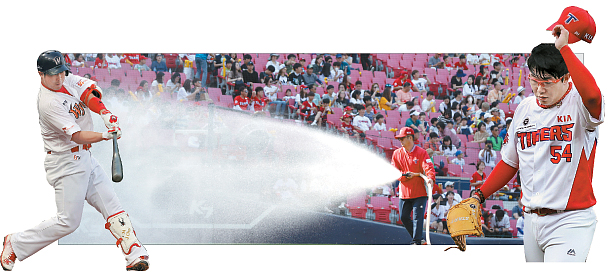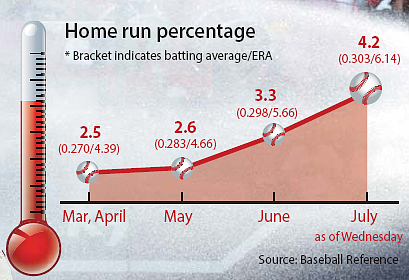Home run records continue to fall as temperature rises

A Kia Tigers’ groundskeeper sprays water on the field before a game. [YONHAP, JOONGANG PHOTO]
Though the Tigers’ concluded a seven game winning streak, the record they set is far more impressive. After defeating the Wyverns 15-6 on Tuesday, the Tigers became the first team in Korea Baseball Organization (KBO) history to win with more than 10 runs for seven consecutive games.
In fact, this is a record that has never been matched in Major League Baseball or Nippon Professional Baseball. During the streak the Tigers scored a total of 94 runs from 119 hits, an average of 13.4 runs per game.
The Tigers weren’t the only team clocking up runs as the season moved into July. In a total of 13 games as of Tuesday, the ten KBO clubs hit at an average of 2.67 home runs and recorded a 0.303 batting average. Meanwhile, the pitchers’ ERA skyrocketed to 6.14.

Normally, pitchers tend to perform weaker in the summer, whereas batters improve as they play more games. With the rise in temperature, the starting pitchers start to fall and the relief pitchers show less power in their pitches.
In April there were five pitchers’ with an ERA below 2.00. Now there are none. Looking at all five KBO games played on June 18, the teams scored a total of 95 runs, the most runs ever scored in a single day in KBO history. The NC Dinos scored 11 runs, but still lost to the Doosan Bears with 13.
In “The Physics of Baseball,” Sterling Professor Emeritus of Physics at Yale University Robert Adair writes that if the temperature rises by five degrees Celsius, the driving distance of a hit also increases by 1.2 meters (4 feet). Once the temperature rises, the air density decreases, so the baseball encounters less friction from the air.
Atmospheric pressure and humidity are important factors in baseball, as they have a direct relationship with temperature. If the humidity increases the air density decreases, which increases the possibility of a long hit, as there is less air pressure surrounding the baseball.
According to baseball-reference.com, a baseball statistics website, when the temperature drops below 40 degrees Fahrenheit, the batting average is 0.251. But as the temperature increases, the batting average also increases. If a game is played at a temperature above 90 degrees Fahrenheit, the batting average is 0.277.
According to KBO analysis, if the temperature increases by 10 degrees Celsius, the slugging average also increases by 12.6 percent.
Up until the 1960s the major league started around April 19. But as the number of games increased, the season opener was pushed back to the beginning of April. Since the weather varies a lot in each state, each club considers the climate when it comes to recruiting players.
BY KIM WON [kang.yoorim@joongang.co.kr]










with the Korea JoongAng Daily
To write comments, please log in to one of the accounts.
Standards Board Policy (0/250자)